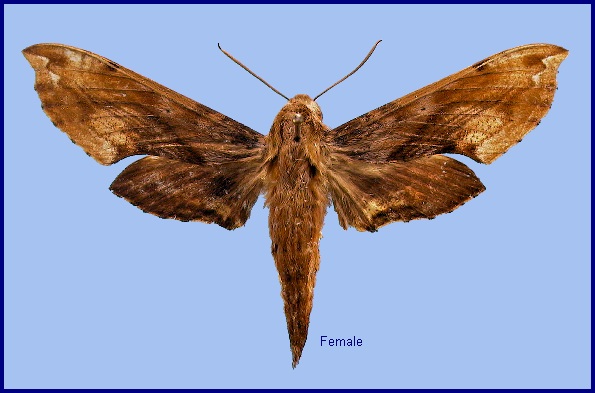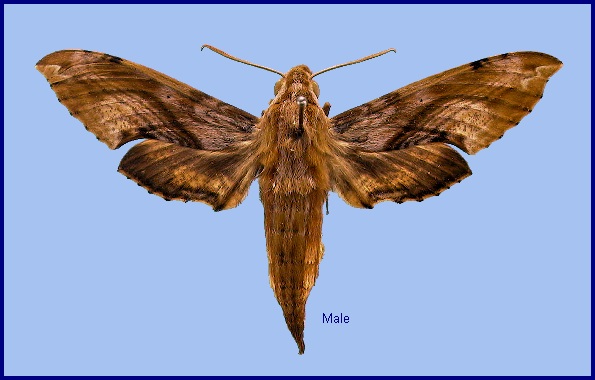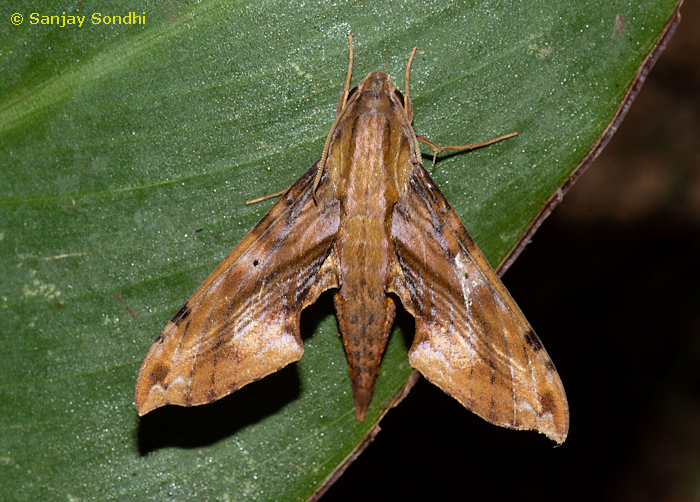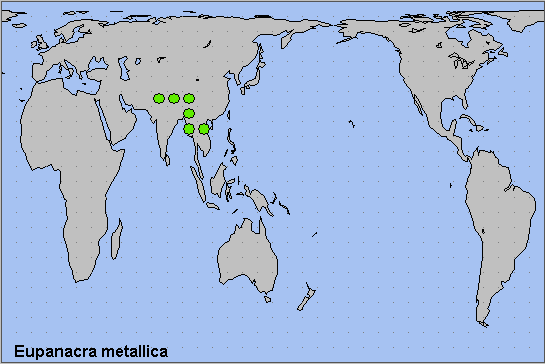

Panacra metallica Butler, 1875, Proc. zool. Soc. Lond. 1875: 6. Type locality: North India [Bangladesh], <<Silhet>> [Sylhet].
Synonym. Panacra metallica Butler, 1875.
Synonym. Panacra metallica anfracta Gehlen, 1930.
Synonym. Panacra sinuata birmanica Bryk, 1944.
Wingspan: 60--73mm. Forewing upperside with postmedian lines less longitudinal than in Eupanacra sinuata, not reaching costa. Forewing underside less extensively brown than in Eupanacra sinuata, with the basal area paler. Hindwing upperside with buff band broader than in Eupanacra sinuata. Hindwing underside largely buff, tinged with brown; buff submarginal area broader than the brown marginal band, and continued to costa, becoming more tawny anteriorly and interrupted anterior to M2; costal margin orange, not grey as in Eupanacra sinuata, and with a large orange brown area between Sc+R and M1. Upperside of thorax and proximal segments of abdomen with a brown lateral stripe. Similar to Eupanacra sinuata but upperside ground colour somewhat more orange.
Male genitalia similar to Eupanacra sinuata but harpe much shorter, resembling that of Eupanacra regularis regularis but more strongly sinuate.

China: vi (Sichuan).
OVUM: Pale green, turning pink before hatching due to the crimson colour of the larva inside.
LARVA: Full-fed 90mm. According to Bell & Scott (1937), in the first instar body long and thin; horn straight, of medium length, shortly bifid, with a bristle on each arm; head very pale green, second and third segments bright bluish-green; rest of body pale crimson in dorsal area, yellowish-green in lateral area; horn with basal half pale purple, rest black. In The second instar, horn long; head pale green; body pale bluish with a darker blue, narrow dorsal stripe from segment 2 to base of horn; an oval eye-spot on segment 5 black above, pale blue below; horn black with small black tubercles on upper surface, pale green on under surface. In the third instar, head pale green, body pale yellowish-green; dorsal stripe black; eye-spot black above, very pale yellow below; a white patch touching the upper edge of the eye-spot, and some white dots between the eye-spot. In the fourth instar, horn long, sharply down-curved, slightly flattened laterally, surface smooth; head and segment two bluish-green, rest of body yellowish-green, with a transverse row of white dots on each secondary ring; ocellus with a reddish longitudinal stripe in the yellow portion; three or four transverse lines, curved backwards, in front of and behind the eye-spot; horn black above, greenish-brown below; spiracles pale brown. In the fifth and final instar, shape as in others of the genus; horn sharply down-curved, slightly flattened laterally, ending in a blunt point. Head dull, body and horn smooth and shining.
In the final instar, head bluish-green. Body bright yellowish-green; dorsal stripe dark brown, narrow on segments 2 and 3, then broad to base of horn; a dark brown subdorsal stripe on 2 to 4; eye-spot centre black above, brown below, the brown portion edged narrowly with white all round, the whole edged with black; a curved white band above the eye-spot; the area between the eye-spots brown flecked with white; a brown patch on 6 to 12, narrow below the spiracle, broadening and turning dorsad at the anterior edge of each of the segments. Horn dirty yellow; true legs green; prolegs green with base and end-segment brown; anal flap and claspers dirty green. Spiracles brown, central slit white.The larva, when small, lies stretched straight out along the midrib on the underside of a leaf, and when alarmed bends the head round to touch the middle of the body. In the last two instars the larva feeds at night, and during the day lies head downwards along the stem of the foodplant close to the ground, or hides under stones and leaves close by. When alarmed it retracts the head and anterior segments into segments 4 and 5, and twists the body round so as to present the ventral surface of the anterior segments to the source of danger. When further molested it sometimes stretches out the head and segments 2 and 3 and bends them downwards and backwards so that the head and anterior segments lie parallel with and close to the venter of 5, which is at the same time expanded. The anterior part of the body is swayed from side to side, and the larva presents a most curious aspect, not noted in any other species. The larva turns greenish-brown before pupation (Bell & Scott, 1937).
PUPA: 50mm. The same shape as others of the genus. Surface dull. Cremaster broadly triangular, ending in a shaft with two hooks at the tip and two sharp spines on each side of the base. Colour of head, thorax and wing-case bright green; eye and surrounding area ochreous; tongue and wing-case speckled with black; abdomen green with dark brown and ochreous strigae. Spiracles dark brown (Bell & Scott, 1937).
Larval hostplants. Arisaema tortuosum in India (Bell & Scott, 1937).
China: Sichuan (Qingcheng Shan, 1500-1800m); Yunnan (Gaoligong Shan); Xizang/Tibet (Zhangmu).
From northwestern India across Nepal, Bhutan (Irungbam & Irungbam, 2019), Bangladesh and northern Burma/Myanmar to southwestern China.

 Return to Sphingidae of the Eastern Palaearctic species list
Return to Sphingidae of the Eastern Palaearctic species list